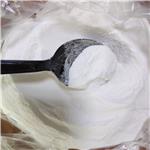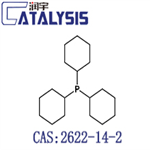Tricyclohexyl Phosphine: Applications in Catalytic Reactions and its Radical Synthesis Method
Jul 15,2024
General Description
Tricyclohexyl phosphine, a versatile organophosphorus compound, plays a key role in catalytic reactions across various chemistry fields. Its involvement in [3 + 2] cycloaddition with [60]fullerene yields cyclopentenofullerenes, valuable for organic photovoltaics. Additionally, tricyclohexyl phosphine-cyclopalladated ferrocenylimine complexes excel in Suzuki and Heck reactions, showcasing remarkable catalytic activity. The efficient synthesis of tricyclohexyl phosphine from tetraphosphorus using a radical approach, with a titanium catalyst, ensures high purity and yields, emphasizing its utility in diverse chemical applications. Overall, tricyclohexyl phosphine's versatility and efficacy underscore its significance in academic research and industrial processes, promising advancements in organic chemistry domains.

Figure 1. Tricyclohexyl phosphine
Applications in Catalytic Reactions
Tricyclohexyl phosphine is a versatile organophosphorus compound widely employed in catalytic reactions across various fields of chemistry. Its unique structure and properties make it particularly suitable for facilitating diverse chemical transformations.
Tricyclohexyl phosphine-Catalyzed Cycloaddition with [60]Fullerene
Tricyclohexyl phosphine plays a pivotal role in catalyzing the [3 + 2] cycloaddition reaction between (E)-alkyl 5-substituted phenylpent-4-en-2-ynoates and [60]fullerene. Initially, PCy3 facilitates a 1,3-addition towards the α-carbons of enynoates, generating reactive 1,3-dipoles. These intermediates subsequently undergo cycloaddition with [60]fullerene, forming cyclopentenofullerenes. The process, accompanied by the elimination of tricyclohexyl phosphines, yields cyclopentenofullerenes in moderate to high yields ranging from 20% to 43%. These cyclopentenofullerenes exhibit promising characteristics as n-type materials in organic photovoltaics. When incorporated into the active layer with P3HT, they contribute to achieving a notable average power conversion efficiency of 3.79 ± 0.29%. 1
Tricyclohexyl phosphine-Cyclopalladated Ferrocenylimine Complexes in Catalysis
Tricyclohexyl phosphine also features prominently in the synthesis of tricyclohexyl phosphine-cyclopalladated ferrocenylimine complexes (2c-2g). These complexes are distinguished by their robust thermal stability and resilience to air and moisture, as evidenced by single-crystal X-ray analysis which reveals intricate structures stabilized by multiple intermolecular hydrogen bonds. These complexes demonstrate significant catalytic prowess in organic synthesis, notably in Suzuki and Heck reactions. In Suzuki reactions, they serve as highly efficient catalysts for coupling aryl chlorides with phenylboronic acid, achieving excellent yields under mild conditions (0.1 mol% catalyst, Cs2CO3 base, dioxane, 100°C). Similarly, in Heck reactions involving aryl bromides and acrylic acid ethyl ester, these complexes exhibit commendable catalytic activity, although their performance varies with substrate specificity. 2
Tricyclohexyl phosphine emerges as a crucial component in both the synthesis of novel cyclopentenofullerenes via [3 + 2] cycloaddition with [60]fullerene and the development of stable cyclopalladated ferrocenylimine complexes for efficient catalysis in Suzuki and Heck reactions. These applications underscore its versatility and utility across diverse domains of organic chemistry, promising continued advancements in both academic research and industrial applications.
Radical Synthesis Method
Introduction to Synthesis Method
Tricyclohexyl phosphine is synthesized efficiently via a radical approach using tetraphosphorus (P4) as the starting material. This method offers a robust pathway to obtain high yields of PCy3, demonstrating its utility in diverse chemical applications.
Radical Synthesis Procedure
The synthesis of tricyclohexyl phosphine begins with a solution of P4 in benzene, to which titanium(3+) salt is added. This initiates a radical reaction, facilitating the conversion of bromocyclohexane into Tricyclohexyl phosphine. The reaction proceeds at room temperature, where careful addition of reactants ensures optimal conditions for the formation of the desired product. The green reaction mixture undergoes transformation, yielding tricyclohexyl phosphine in exceptional purity and yield, notably achieving up to 95%.
This radical synthesis method innovatively utilizes titanium as a catalyst, allowing for direct functionalization of white phosphorus without the traditional intermediate steps involving compounds like PCl3. Detailed analysis through NMR spectroscopy confirms the identity and purity of Tricyclohexyl phosphine, employing OPPh3 as an internal standard for accurate characterization. This synthetic approach not only underscores the efficiency of Tricyclohexyl phosphine production but also highlights its potential for further applications in catalysis and organic synthesis. 3
Reference
1. Wu AJ, Tseng PY, Hsu WH, Chuang SC. Tricyclohexylphosphine-Catalyzed Cycloaddition of Enynoates with [60]Fullerene and the Application of Cyclopentenofullerenes as n-Type Materials in Organic Photovoltaics. Org Lett. 2016; 18(2): 224-227.
2. Xu C, Gong JF, Yue SF, Zhu Y, Wu YJ. Tricyclohexylphosphine-cyclopalladated ferrocenylimine complexes: synthesis, crystal structures and application in Suzuki and Heck reactions. Dalton Trans. 2006; 39: 4730-4739.
3. Cossairt BM, Christopher CC. Radical synthesis of trialkyl, triaryl, trisilyl and tristannyl phosphines from P4. New Journal of Chemistry. 2010; 8: 1533-1536.
- Related articles
- Related Qustion
- Synthesis method of tricyclohexyl phosphine Aug 18, 2022
Tricyclohexyl phosphine is the tertiary phosphine.
Potassium pyrophosphate exhibits unique physical properties and serves as a viable alternative in osmotic evaporation due to its comparable permeate flux values.....
Jul 15,2024API2-Hydroxyethyl Acrylate is crucial in pH-responsive hydrogels, requiring careful handling to prevent polymerization and mitigate health risks.....
Jul 15,2024APITricyclohexyl phosphine
2622-14-2You may like
Tricyclohexyl phosphine manufacturers
- Tricyclohexyl phosphine
-

- $0.00 / 1kg
- 2024-01-04
- CAS:2622-14-2
- Min. Order: 1kg
- Purity: 98%
- Supply Ability: 20ton
- Tricyclohexyl phosphine
-

- $0.00 / 1kg
- 2023-09-27
- CAS:2622-14-2
- Min. Order: 1kg
- Purity: 99%
- Supply Ability: 100tons
- Tricyclohexyl phosphine
-

- $0.00 / 100g
- 2023-07-27
- CAS:2622-14-2
- Min. Order: 1KG
- Purity: 0.99
- Supply Ability: 500kg




